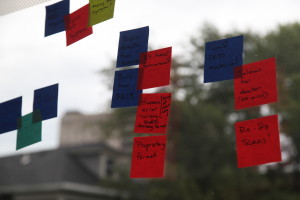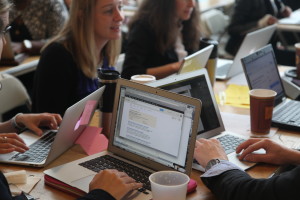 Hackathons are quickly growing beyond Red Bull- and Dorito-fueled code-fests into fertile grounds for new technologies and products that potentially could improve medicine and health care.
Hackathons are quickly growing beyond Red Bull- and Dorito-fueled code-fests into fertile grounds for new technologies and products that potentially could improve medicine and health care.
But beyond individual events, could hackathons signal the beginnings of a new ecosystem for medical innovation?
That’s what groups like MIT’s H@cking Medicine, Brigham and Women’s Hospital (BWH)’s new iHub and the New Media Medicine group at the MIT Media Lab are betting on. By tapping the same creative entrepreneurial energy that hackathon culture has brought to the technology industry, they believe they can fundamentally reimagine health care, one device, app and system at a time.
“The Boston area is the most fertile ground for medical innovation you could ever imagine,” says Michael Docktor, MD, a gastroenterologist at Boston Children’s and one of the organizers, with the H@cking Medicine team, of this weekend’s Hacking Pediatrics hackathon. “We need to make the case with the local medical and technology community that hackathons are a viable way of innovating in this day and age, that this is the way we ought to be innovating.”
Hack-a-what?
Your typical hackathon is a multi-day gathering—sometimes three days, sometimes nearly two weeks—of engineers, designers, programmers, business people and more, divided into three segments:
- Day 1: The pitch. Teams gather around a challenge and decide what they want to tackle. At health care hackathons, usually a doctor or other health provider on the team pitches a “pain point” or problem that becomes the focus.
- Following day(s): Design and build. The “no-sleep” part of the hackathon, where teams settle on a solution—or a “hack”— and start to build prototypes. It won’t be a be-all, end-all fix, but could be something that addresses a particular aspect of the problem.
- Last day: The demo. The teams come back and demonstrate the solutions they’ve developed.
“Many people misunderstand what ‘hacking’ means in this context,” says Zen Chu, a serial entrepreneur and the faculty advisor for H@cking Medicine. “This isn’t bad, black-hat hacking, but clever solutions or tricks. Those clever tricks can change the fundamental way you provide health care and everything about the patient experience.”
The right stuff: speed, money and people
As an innovation engine, the hackathon’s entrepreneurial strength lies in three key features: speed, cost and engagement of people from diverse backgrounds. Together, those elements provide a spark for creative thinking.
“We tend to get in a groove where we think there’s only one way to solve problems,” Chu notes. “Entrepreneurship acts as a lens to help unleash what people care about and the ideas that they bring, and coalesce them into diverse teams with very different perspectives.”
“The way innovation happens at big firms is slow and expensive,” says Andrea Ippolito, a doctoral student at MIT, co-leader of H@cking Medicine and co-founder of Smart Scheduling, a company born of a H@cking Medicine hackathon last year. “Hackathons are quick and iterative in a short period of time, they convene the right stakeholders and they do it quite inexpensively.”
Docktor, too, credits the hackathon model’s emphasis on putting the right people together in the same place.
“Dozens of MBA students and engineers want to have an impact in health care, but don’t understand the health care environment,” Docktor says. “And hundreds of clinicians come up with great ideas every day. But many of these ideas die on the vine, because they have no idea of how to run a business or create a prototype or how to connect with a designer or an engineer.
“If we give them access to the right resources,” he adds, ” they can do fantastic things.”
And fantastic things are coming out of health care hackathons. Consider:
- The Chameleon and the GeckoCap, two Web-connected asthma management devices for children, grew out of the New Media Medicine group’s 2012 Health and Wellness Innovation hackathon.
- Aeon—a combination of apps, games, a tremor-detecting mug (the Tremo) and a motion-sensing glove (the Brady Glove)—for Parkinson’s disease patients, was developed during the New Media Medicine group’s 2013 event.
- The Ring Leader, a wearable ring that uploads heart rate and other heart data, emerged from a recent hackathon held by H@cking Medicine and BWH’s iHub.
- Ippolito’s Smart Scheduling system, which predicts patient no-shows and same-day cancellations, reduces scheduling errors and improves access to care.
- Pill Pack, a personalized pharmacy delivery service, packages medicines for patients with multi-drug regimens, with reminders of what to take and when.
Taking the long view
The true potential for the hackathon model, Docktor thinks, lies in the opportunity to go beyond single events into a permanent mindset and, in turn, more permanent resources for health care innovators, like BWH’s iHub or Boston Children’s Innovation Acceleration Program.
“We want to foster this collaborative environment in the long term,” Docktor says. “If a nurse or doctor has a great idea in April and the next hack isn’t until October, that shouldn’t stop him or her,” Docktor says. “We should have the resources available to put them together with engineers and business people and create something awesome.”
Emergency physician Adam Landman, MD, chief medical information officer for health information innovation and integration at BWH and an organizer of a recent iHub/H@acking Medicine event, agrees that the hack-based innovation environment needs a long-lasting element, noting that the key to a successful hackathon isn’t necessarily what happens during the actual event.
“If you have an event and don’t do anything afterward, you won’t get as much out of it for the participants or the institutions,” he notes. “We want to work closely with the teams to help them iterate their ideas and thinking and move their projects forward.”
That kind of ecosystem is starting to come together in medicine, as evidenced by the growth of incubators and accelerators like Healthbox or Blueprint Health, built on the model of Silicon Valley’s Y Combinator. These firms typically provide seed money to early-stage ventures, along with guidance and connections to possible investors and partners. “There’s been an explosion of health care accelerators in the last two or three years,” Ippolito says.
So can hackathons and the entrepreneurial spirit they embody fundamentally change the way we approach health care? For Chu, the answer is an unequivocal yes.
“With the intersection of new technologies; the ubiquity of mobile, very powerful computers in our pockets; the decreasing costs of sensors and the rise of new diagnostics and genomic sequencing, there’s never been a better time to be a health care entrepreneur,” he says. “I fundamentally believe that entrepreneurship will provide the solution for what’s wrong with health care, not just in America but across the world.”
Hacking Pediatrics will take place this weekend, sponsored by Boston Children’s Hospital and H@cking Medicine. You can track the event on Twitter by following @HackPediatrics or the hashtag #hackpeds.









